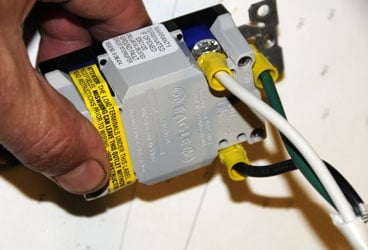
avoid shock 368
Shore power and the luxuries it affords-literally the comforts of home-can be enjoyed aboard your boat, thanks to the yellow cord from the dock or your generator and inverter. With this luxury, however, comes a responsibility on the part of the skipper to ensure that all elements of the electrical system are installed in a manner that presents the least possible risk to the crew.
The voltage and current supplied by a vessel’s shore-power system, regardless of the source, is essentially the same as that found in buildings on land, which means it’s potentially lethal. Shore cords, inverters, and generators all supply a minimum of 120 volts, and in some cases they supply 240 volts-both well beyond the 50 volts that can cause electrocution. To keep marine circuits as safe as possible, an owner should make sure that ground fault interrupter receptacles are properly installed.
A GFI receptacle monitors the current supply and return traveling over the two-wire electrical system typically found in the AC system of your house or boat. The power that makes a round trip to your blender or reciprocating saw, for instance, keeps the GFI receptacle in a state of equilibrium. When a fault occurs-you cut through the saw’s cord or drop the blender into a sink full of water-the electricity being supplied to the tool or appliance finds an alternative path back to its source or ground rather than through its own cord. When this alternative return path exceeds approximately 5 milliamps (0.005 amps), it upsets the equilibrium inside the GFI receptacle, which, in the blink of an eye, causes the receptacle to trip, shutting off the power to the fault-and, in a worst-case scenario, to you-in as little as 0.025 seconds.
The American Boat & Yacht Council recommends the use of GFIs in galleys, heads, and engine compartments and on deck. In my opinion, they should be used throughout every vessel. This is easier to make happen than it sounds, as one GFI receptacle can protect several ordinary receptacles located farther down a circuit.
Installation is really quite easy because GFI receptacles can replace conventional receptacles wire for wire. No additional connections are required.
If the GFI is protecting other receptacles that are electrically downstream, be sure to follow instructions included with and affixed to most GFIs about where to connect the incoming and outgoing wires.
Once you’ve installed a GFI receptacle, or if you already have them on your boat, you should test them monthly by tripping them manually. Better still, buy a GFI tester at a home-improvement store for $15; this will give you a much more definitive test than the integral push button offers. Using one of the plug-in testers will also tell you if the receptacle is wired properly because it identifies most, but not all, wiring and GFI faults. If you want the Cadillac of receptacle testers, be prepared to shell out about $275 for an Ideal Sure Test.
Considering the price of a GFI receptacle, about $10, the insurance is cheap indeed. GFI receptacles used aboard boats should be Type A and UL 943 and 498 compliant.
Additionally, if your vessel is equipped with an inverter, it’s critically important that you determine from the manufacturer which GFI receptacles are recommended and guaranteed to work properly. Most inverter manufacturers provide a GFI compatibility list or offer recommendations for units that are known to work properly.
Steve D’Antonio offers services for boat owners and buyers through Steve D’Antonio Marine Consulting (www.stevedmarineconsulting.com).








